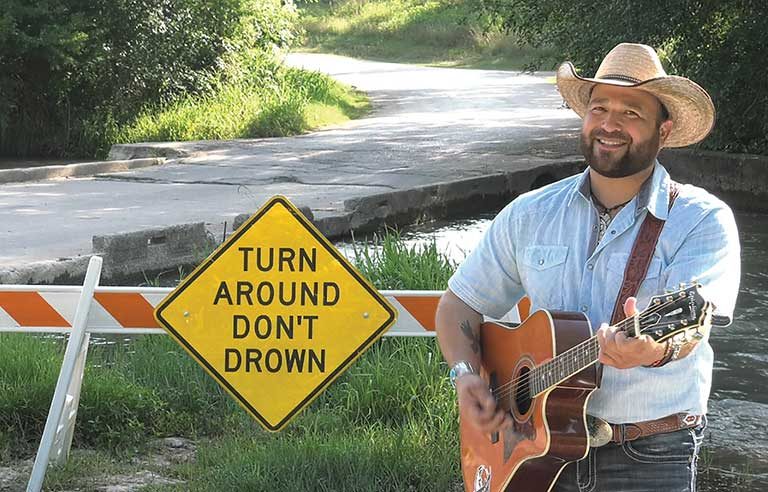Steer clear of floodwaters
‘Turn Around – Don’t Drown,’ weather and safety experts say

Water has flooded the road along your errand route. But it looks to be only a few inches deep.
“Can I make it across?” you ask yourself. “Or should I find another way?”
The second question holds the right answer. Six inches of floodwater can cause passenger cars to lose control and stall, the National Weather Service warns. Twelve inches of fast-moving floodwater is enough to carry away most cars, while 24 inches can displace a majority of trucks and SUVs. A jingle for the agency’s “Turn Around – Don’t Drown” flood safety campaign lasts only 30 seconds, but officials hope the message – sung by Lytle, TX-based country music artist Matt Hawk – can help save countless lives.
With Hawk’s lyrics as inspiration and expert insight as guidance, Family Safety & Health explores flood safety on the road.
“If the water is flowing at the low-water crossing/Turn around, turn around”
Flooding can happen anywhere in the country.
“There’s flooding that occurs from rapidly melting snow, from tropical systems and from heavy rain,” said Kate Abshire, National Flash Flood Services lead at the NWS. “And one of the things that we want to stress is that it’s a year-round hazard. It can occur at any time of the year and it happens in all 50 states.”
Reflecting on the various flood rescue calls he has responded to during his career, Tim Vaughan, emergency response services medical supervisor for the Butler County (OH) Sheriff’s Office, says many drivers simply underestimate the power of moving floodwater.
“Don’t try to drive across flooded roadways,” Vaughan said. “Never cross a barrier.”
Whether the water has inundated the area for a long period of time or suddenly risen because of flash flooding, it’s capable of carrying your vehicle away.
“It’s a loss of contact with the road that’s causing the vehicle to float,” Abshire said. “But then, you have to think the vehicle itself is quite buoyant, too, and it doesn’t take that much water to be able to float a vehicle. So the water is pushing the car forward and it’s also pushing the car up off the road with the force of the water.”
“Don’t risk your life, don’t do it/You might not make it through it/Turn around, turn around”
Why did the driver attempt to cross the flooded road? Here’s anecdotal evidence from one expert.
“What we see is people have a false sense of security that, ‘I have a full-size SUV or a big truck and I’ve been living in this area my whole life. I’m not going to let a little bit of water slow me down,’ and then make that poor decision to cross it,” South Carolina Highway Patrol Officer David Jones said. “And what they don’t know is what’s in the water or what’s underneath, and their vehicle gets swept away or, in some cases, they ran off into these washed out roads that (were) 15-, 20-feet deep and they lost their life.”
Abshire said that despite the guidelines regarding how much water it takes to sweep a vehicle away, accurately gauging the depth of the water and condition of the submerged road is difficult. The road may have collapsed – partially or completely. “Even after the water recedes, it may be important to check the condition of the road,” Abshire said. “Water can sort of undermine culverts or undermine the road, and so the road may not be stable or safe for you to drive on after a significant flood, either.”
“Might take a little time/But heed the warning signs and/Turn around, turn around”
Jones recommends familiarizing yourself with alternate routes. If you know you’ll be traveling during severe weather or passing through a flood-prone area, prepare an emergency kit with food, water and blankets, and make sure your cellphone is fully charged or you have a spare.
In the event that alternate routes are also impassable and severe weather remains in the area, search for higher ground and notify emergency officials immediately.
“If you’re stuck, if you’re trapped somewhere in rising waters, definitely call for help,” Vaughan said. “If you have to abandon your vehicle and walk up a steep hill, you would rather do that because the vehicle is going to wash away and it’s not going to stay put.”
“Turn around, turn around, turn around/And don’t drown”
“That’s really the only safe thing to do,” Abshire said.
Added Jones: “We can’t stress enough: Don’t attempt to cross these roads.”
Post a comment to this article
Safety+Health welcomes comments that promote respectful dialogue. Please stay on topic. Comments that contain personal attacks, profanity or abusive language – or those aggressively promoting products or services – will be removed. We reserve the right to determine which comments violate our comment policy. (Anonymous comments are welcome; merely skip the “name” field in the comment box. An email address is required but will not be included with your comment.)
